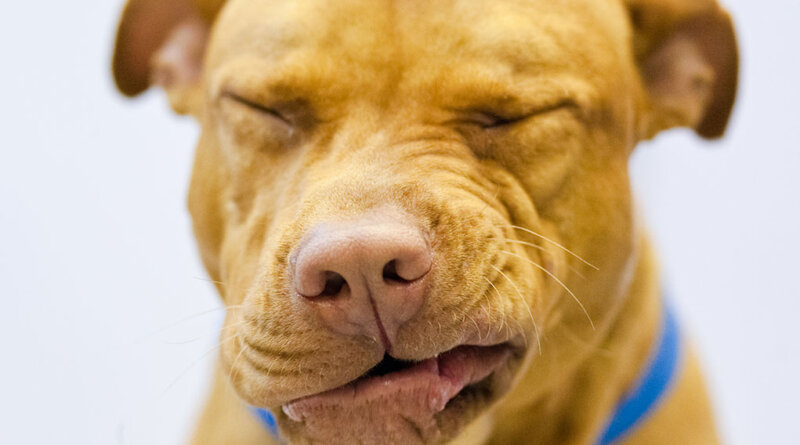Causes and Treatments – Top Dog Tips
Reverse sneezing is a common respiratory condition in dogs.
Mainly caused by irritation or inflammation of the nasal, pharyngeal, or sinus passages.
What Is Reverse Sneezing in Dogs?
Reverse sneezing occurs if a dog’s soft palate is irritated, thus, causing the soft palate to spasm, narrowing the trachea.
The soft palate is the muscular area at the back of the roof of the mouth that assists with vocalization, swallowing, and breathing.
The dog will try to extend its neck and expand its chest to breathe, but the narrowed trachea inhibits the dog from breathing air.
However, the dog will try to forcefully inhale through its nose, which causes a dog to sneeze backward.
Diagnosing Reverse Sneezing in Dogs?
Diagnosing reverse sneezing involves observing a dog based on its appearance and sounds during an attack.
The veterinarian will recommend diagnostic tests to rule out conditions such as infections, parasites, or underlying illnesses.
Standard diagnostic tests include nasal swabs, x-rays, allergy testing, and overall health check, e.g., bloodwork.
What Does It Sound Like?
Reverse sneezing sounds like inhaling sneezes, and it’s a loud snorting sound, the same as a goose honking.
How Long Does It Last?
Reverse sneezing in dogs lasts for 30 seconds or less. Sometimes, it may take a minute or two.
Although longer durations occur, it’s rare for a dog to have two episodes in 24 hours. If this happens to your dog, you may report it to your veterinarian.
What Causes Reverse Sneezing?
A simple sneeze helps release irritants in the nasal cavity. As well as cough expels irritants located down the trachea.
A reverse sneeze in dogs is their body’s way of releasing irritants in the nasopharynx or soft palate.
These are some of the possible causes of irritation in the soft palate of dogs that results to reverse sneezing:
- Allergies
- Nasal mites
- Perfume
- Cleaning household products
- Air fresheners
- Overexcitement
- Pulling on the leash with attached collar
- Exercise intolerance
- Eating
- Drinking
- Foreign objects in the throat
- Elongated soft palate (breeds with a short snout)
A small fiberoptic scope can also help examine your dog’s nasal cavity and soft palate.
What Happens During Reverse Sneezing?
During a reverse sneeze, a dog will exhibit these actions:
- Standing still
- Extends head and neck
- Produce a loud snorting sound
Reverse sneezing is different from a tracheal collapse, producing a loud honking sound.
Tracheal collapse is more severe than reverse sneezing.
When to Worry?
While there is nothing to worry about reverse sneezing, if it becomes frequent, it’s best to have your pet get consulted by a veterinarian.
Some respiratory illnesses can spread to other pets if not adequately attended to. It can become life-threatening.
Veterinarians commonly diagnose pets with the following breath-related concerns:
- Asthma
- Upper respiratory infections
- Brachycephalic syndrome
- Collapsing trachea
- Heart disease
Vets will also recommend having your pet undergo diagnostic testing such as bloodwork or radiographs to know what causes the problem.
RELATED ARTICLE: Dog Breathing Problems
Treatment for Reverse Sneezing in Dogs
There’s no necessary treatment or medication for reverse sneezing because the spasm is over once the sneezing stops.
Also, there are ways you can help your dog to stop the spasm:
- Pick your dog and change his position. Either head up or head down to help shift the soft palate.
- Let your dog swallow and clear the irritation by massaging his throat or blocking his nostrils.
- Distracting your dog with food or toy
- Pressing down his tongue to make him take a mouthful of breath, and this will open up the back of his nose.
If the attacks become more severe, vets will likely perform chest x-rays and rhinoscopy to look for abnormalities.
Dog Breeds That Are Prone to Reverse Sneezing
Reverse sneezing can happen with any dog.
However, it’s more common in Brachycephalic dog breeds.
In alphabetical order, Brachycephalic dog breeds include:
- Affenpinschers
- American Bulldogs
- Boston Terriers
- Boxers
- Brasileiros
- Brussels Griffons
- Bullmastiffs
- Cane Corsos
- Cavalier King Charles Spaniels
- Chow Chows
- Dogos Argentinos
- Dogues de Bordeaux
- English Bulldogs
- English Toy Spaniels
- French Bulldogs
- Japanese Chins
- Lhasa Apsos
- Mastiffs
- Neapolitan Mastiffs
- Newfoundlands
- Pekingese
- Pugs
- Shar Pei
- Shih Tzu
- Staffordshire Bull Terriers
- Tibetan Spaniels
Is Reverse Sneezing Harmful to Dogs: Bottom Line
There is nothing to worry about reverse sneezing for most dogs, as it is not harmful.
Usually, it occurs for less than a minute. Afterward, dogs will return to their normal activities.
If your dog develops reverse sneezing, it’s always best to have it consulted with a veterinarian.
Some symptoms that may lead to asthma, heart disease, and tracheal collapse include:
- Frequent wheezing
- Consistent cough
- Labored breathing
- Panting
- Open-mouth breathing
- Lethargy
- Pale or blue gums
- No interest in exercise
If dogs reverse sneeze more often, this may require a general anesthetic and a small flexible scope.
In some cases, vets might trim the soft palate if it’s too long.
RELATED ARTICLE: Dog Health Symptoms That You Must Address Right Away
Related








I like this blog very much so much wonderful info .
I have been absent for a while, but now I remember why I used to love this web site. Thanks , I will try and check back more often. How frequently you update your site?
Hmm it appears like your blog ate my first comment (it was super long) so I guess I’ll just sum it up what I wrote and say, I’m thoroughly enjoying your blog. I as well am an aspiring blog blogger but I’m still new to everything. Do you have any recommendations for novice blog writers? I’d really appreciate it.
I am really impressed with your writing abilities as well as with the format in your weblog. Is this a paid theme or did you modify it your self? Either way keep up the nice quality writing, it is rare to look a great weblog like this one these days..
What is FlowForce Max? FlowForce Max Advanced Formula is a holistic blend designed to promote optimal prostate health
What Is FitSpresso? It is a nutritional formula that is produced by the Natures Formulas.
Whats up! I simply want to give a huge thumbs up for the great information you’ve here on this post. I will probably be coming again to your blog for extra soon.
Hi there, just changed into alert to your blog via Google, and found that it’s truly informative. I’m going to watch out for brussels. I will be grateful in the event you proceed this in future. A lot of folks will probably be benefited from your writing. Cheers!